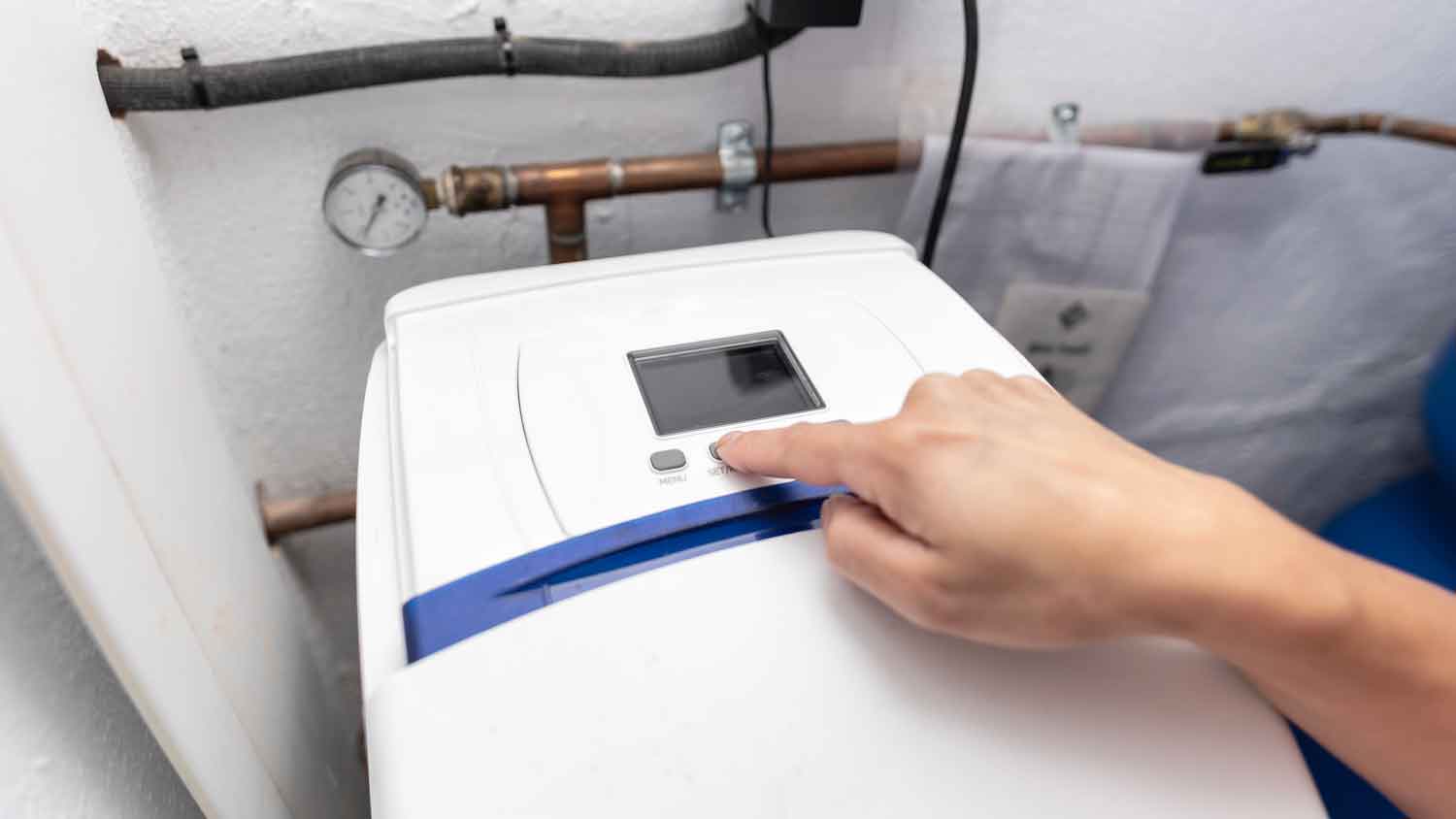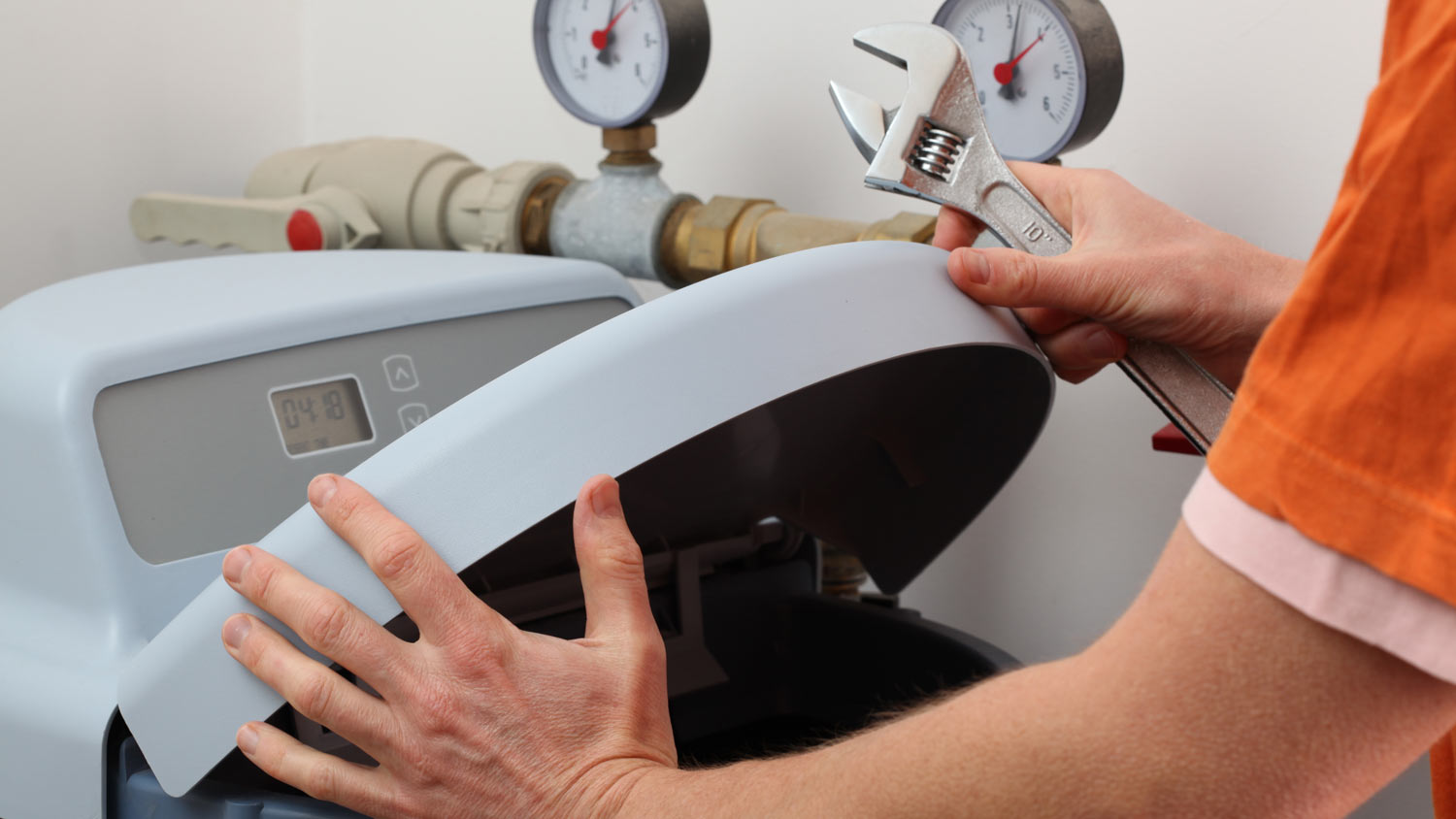
Use this guide to budget for water softener repair costs based on factors such as water treatment system type, replacement parts, professional labor, and more.
A reverse osmosis water filter costs $2,200 on average, but prices depend on the type of filter, its efficiency, and labor.


Reverse osmosis systems help ensure cleaner water by filtering out contaminants.
Some projects dip to $150 or climb to $10,000, with an average of $2,200.
Regular filter replacements every six to 12 months are key to maintaining water quality.
Choosing between a whole-home and point-of-use system affects how much you spend.
This article was created using automation technology and thoroughly fact-checked and edited by HomeAdvisor Editor Ryan Noonan.
Installing a reverse osmosis (RO) water filter system is one of the quickest ways to get cleaner water at home. The average project ranges from $1,000 to $4,800, with most homeowners landing around $2,200. Your final price also depends on the system’s design, performance features, and local labor rates.
Hiring a professional plumber to install your reverse osmosis water system is a wise choice that protects your investment and ensures the system operates properly.
There are two types of reverse osmosis systems: whole home and point-of-use. These systems vary in their design, functionality, and price point.
| System Type | Average Cost Range |
|---|---|
| Whole-home | $1,000–$4,800 |
| Point-of-use - countertop | $200–$700 |
| Point-of-use - tankless | $250–$900 |
| Point-of-use - under sink | $200–$800 |
Also known as point-of-entry systems, whole-home reverse osmosis systems treat water the moment it enters your house from the main water line. A whole-home RO water filtration system costs between $1,000 and $4,800 and are best for homes using well water, rainwater, or water with high levels of contaminants.
Point-of-use systems are attached to specific faucets and only treat the water from that tap. Depending on the system design, point-of-use systems range in price from $200 to $900. Point-of-use systems are available in models for countertops and tankless or tank designs for under-sink cabinets.
Countertop systems are the most budget-friendly, while under-sink tank systems are the most costly.
Reverse osmosis systems measure efficiency by how quickly filtered water is produced and how much water is lost during the process. New high-efficiency systems have a 1-to-1 ratio, with 1 gallon of waste per filtered gallon. Less efficient systems can waste up to 4 gallons of water per gallon of filtered water produced. You can expect to pay up to $300 more for a high-efficiency system.
The number of stages in a reverse osmosis system determines the level of filtration. Most systems feature three to seven filtration stages, and the higher the number of stages.
The National Sanitation Foundation sets ratings for water treatment filters that guarantee the system’s level of filtration. The higher the number of stages and the higher a system's NSF rating, the more the system will cost.
| Number of Stages | Average Starting Cost |
|---|---|
| 3 | $190+ |
| 4 | $210+ |
| 5 | $230+ |
| 6 | $280+ |
| 7 | $300+ |
Expect to spend between $300 and $700 on labor when you hire a water softener installer to put in an RO system. A simple point-of-use unit runs $100 to $300 to install, while a whole-house system can reach $1,500. Local plumbers charge $45 to $200 per hour.
On top of the cost of your RO unit, you’ll also need to budget for ongoing costs to keep your system in tip-top shape.
To keep your reverse osmosis system running smoothly, it’s essential to change the filters regularly. Many homeowners aim for once a year, but swapping them out every six months can help maintain the best water quality. Basic filter sets range from $40 to $90, but if your system is larger or relies on specialized filters, you could spend anywhere from $100 to $300 per year on replacements.
The membrane inside your RO system plays a critical role in filtering out contaminants. It’s a separate component from the filters and is installed horizontally above them. Unlike filters that need frequent changes, the membrane can last two to five years before it needs replacing. Expect to spend about $30 to $100 when it’s time for a new one.
Most RO water systems don’t require much day-to-day attention, but they do need occasional care to stay in peak condition. Plan to sanitize the system and inspect it for leaks about once a year. Many homeowners can handle this maintenance themselves by following the system’s manual, which can save on service costs.
If you come across issues like persistent leaks or pressure problems, it’s a good idea to bring in a licensed plumber or water filtration specialist.
You can tailor a system with smart monitoring, tankless operation, extra pumps, or remineralization cartridges, but each add-on increases the price:
Cost to add a booster pump: $50–$300
Cost to add an alkaline remineralization kit: $150–$300
The value a reverse osmosis system adds to your home depends on the type and quality of the system installed. While countertop or under-sink systems offer the benefit of clean water at specific taps, they’re often not enough to increase your home value. Whole-home systems filter water from any faucet in the house, so they may increase value and attract potential buyers.
A reverse osmosis system is a sizable investment, but you can trim expenses with these budget-friendly tips:
Choose a cost-efficient system with the minimum efficiency and NSF rating for your needs.
Compare prices from local contractors to find the most affordable option in your area.
Opt for a point-of-use system rather than a whole-home system.
Keep up with regular maintenance to prevent costly repairs.
If you go for a DIY installation for your RO system, you will save $150 to $300 on labor costs. You can get the job done with a wrench, screwdrive, and basic plumbing knowledge. However, it’s better to hire a pro to install a whole-home RO system.
Hiring a local plumbing professional is a smart investment that can save you the time and stress of attempting this as a DIY project. A plumber is experienced with these systems and can properly and efficiently install yours while avoiding costly plumbing mistakes or water damage. They also have the knowledge to make expert recommendations on the type of system that’s best for your needs and provide maintenance tips that will help extend the life of your reverse osmosis system.
No place is more important than your home, which is why HomeAdvisor connects homeowners with local pros to transform their houses into homes they love. To help homeowners prepare for their next project, HomeAdvisor provides readers with accurate cost data and follows strict editorial guidelines. After a project is complete, we survey real customers about the costs to develop the pricing data you see, so you can make the best decisions for you and your home. We pair this data with research from reputable sources, including the U.S. Bureau of Labor Statistics, academic journals, market studies, and interviews with industry experts—all to ensure our prices reflect real-world projects.
From average costs to expert advice, get all the answers you need to get your job done.

Use this guide to budget for water softener repair costs based on factors such as water treatment system type, replacement parts, professional labor, and more.

Find out who repairs water softeners and who to call—water softener companies or plumbers—and learn what to expect before you book

Who installs water softeners? Learn whether to call a plumber or technician, how pros get it done, and what installation costs

If you’re planning to install a water softener, consider budgeting based on capacity, type of system, tank size, and more.

The cost of installing a whole-house water filtration system depends on the type and number of filters you choose. Use this guide to budget for your project.